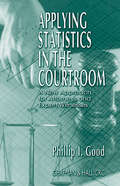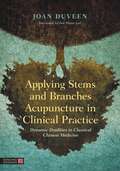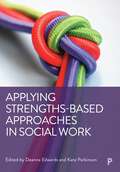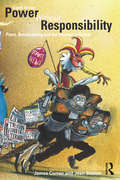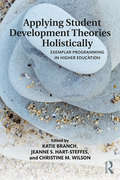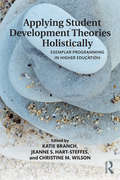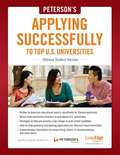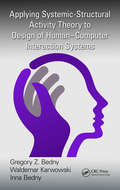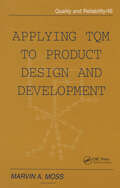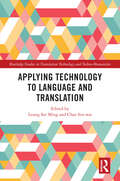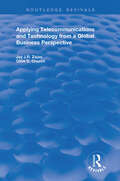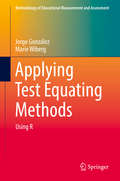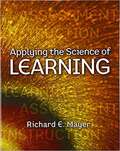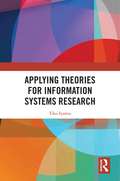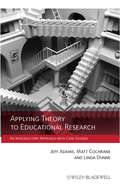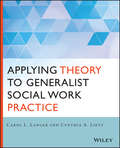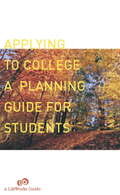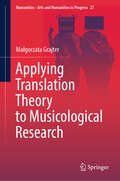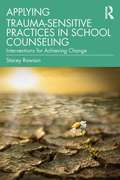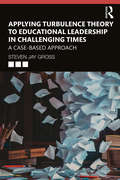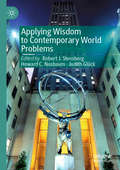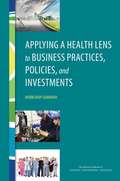- Table View
- List View
Applying Statistics in the Courtroom: A New Approach for Attorneys and Expert Witnesses
by Philip GoodThis publication is directed at both attorneys and statisticians to ensure they will work together successfully on the application of statistics in the law. Attorneys will learn how best to utilize the statistician's talents, while gaining an enriched understanding of the law relevant to audits, jury selection, discrimination, environmental hazards, evidence, and torts as it relates to statistical issues. Statisticians will learn that the law is what judges say it is and to frame their arguments accordingly. This book will increase the effectiveness of both parties in presenting and attacking statistical arguments in the courtroom. Topics covered include sample and survey methods, probability, testing hypotheses, and multiple regression.
Applying Stems and Branches Acupuncture in Clinical Practice: Dynamic Dualities in Classical Chinese Medicine
by Joan DuveenClassical acupuncture according to the philosophy of the heavenly stems and earthly branches uses the fundamental, cyclical rhythms of nature and life as a foundation for health and development. This book is one of the first of its kind in the western world to offer a practical and scholarly approach to applying this philosophy to clinical practice. This handbook guides the practitioner into a journey of better understanding of the self and provides the theoretical background to be able to confidently diagnose and treat patients. It offers invaluable insight into the use of Chinese philosophy, psychology and pulse diagnosis.
Applying Strengths-Based Approaches in Social Work
by Deanna Edwards and Kate ParkinsonThis textbook offers students and practitioners an accessible introduction to strengths-based approaches in Social Work and Social Care practice. Covering the theory and research in support of these approaches, and packed full of case studies, the book will allow readers to develop a critical understanding of how strengths-based approaches work, and how they can be successfully applied in order to improve outcomes for people with lived experience. Covering the five main models of strengths-based practice, the text presents international research and evidence on the efficacy of each approach, enabling students and practitioners to apply the benefits in their own social work practice. The guide features the perspectives of people with lived experience throughout and includes the following key learning features: • case studies of best practice; • points for practice: succinct tips for practitioners and students on practice placement; • further reading list and resources; • glossary.
Applying Student Development Theories Holistically: Exemplar Programming in Higher Education
by Katherine Branch Jeanne Hart-Steffes Christine WilsonThis book dives into student development theory, unpacking key foundational and emergent theories of college student development while providing contemporary examples and application. Helping aspiring higher education and student affairs practitioners grasp and use theories holistically, this important text brings to life theoretical knowledge to enhance the development and learning of college and university students. Showcasing a diversity of programs, practices, and services across a variety of institutional types, Applying Student Development Theories Holistically demonstrates how professionals are intertwining the science of theory with the art of practice in multidimensional, holistic ways.
Applying Student Development Theories Holistically: Exemplar Programming in Higher Education
by Katherine Branch Jeanne Hart-Steffes Christine WilsonThis book dives into student development theory, unpacking key foundational and emergent theories of college student development while providing contemporary examples and application. Helping aspiring higher education and student affairs practitioners grasp and use theories holistically, this important text brings to life theoretical knowledge to enhance the development and learning of college and university students. Showcasing a diversity of programs, practices, and services across a variety of institutional types, Applying Student Development Theories Holistically demonstrates how professionals are intertwining the science of theory with the art of practice in multidimensional, holistic ways.
Applying Student Development Theories Holistically: Exemplar Programming in Higher Education
by Katherine Branch Jeanne Hart-Steffes Christine WilsonThis book dives into student development theory, unpacking key foundational and emergent theories of college student development while providing contemporary examples and application. Showcasing a diversity of programs, practices, and services across a variety of institutional types, Applying Student Development Theories Holistically demonstrates how professionals are intertwining the science of theory with the art of practice in multidimensional, holistic ways. Helping aspiring higher education and student affairs practitioners grasp and use theories holistically, this important text brings to life theoretical knowledge to enhance the development and learning of college and university students.
Applying Successfully to Top US Universities
by Jason MorrisPeterson's Applying Successfully to Top U.S. Universities is a unique guide that assists highly ambitious Chinese students to get accepted to one of the top-ranked higher-education institutions in the United States, to both undergraduate and graduate programs of study. The book starts out with a general overview of what to expect from receiving a higher education in the United States, from earning a degree to financial aid, from campus life to the academic calendar. You will find an entire chapter dedicated to the rankings of schools and universities: who creates the rankings, how to read them, and what to do with the information provided by them. This book also offers extensive information about the language proficiency and admittance tests you may have to take and advice on how to handle the financial aspect of a U.S. education, with a list of scholarships and financial aid available. You will find valuable strategies for building a strong and successful application, with special emphasis on creating an outstanding essay or statement of purpose and securing strong letters of recommendation. The book concludes with extensive advice from admission officers and successful international students.
Applying Systemic-Structural Activity Theory to Design of Human-Computer Interaction Systems (Ergonomics Design & Mgmt. Theory & Applications)
by Waldemar Karwowski Gregory Z. Bedny Inna BednyHuman Computer Interaction (HCI) is no longer limited to trained software users. Today people interact with various devices such as mobile phones, tablets, and laptops. How can such interaction be made more user friendly, even when user proficiency levels vary? This book explores methods for assessing the psychological complexity of compute
Applying Systems Thinking to Regenerative Medicine: Proceedings of a Workshop
by Board on Health Sciences Policy Health and Medicine Division Forum on Regenerative MedicineRegenerative medicine products, which are intended to repair or replace damaged cells or tissues in the body, include a range of therapeutic approaches such as cell- and gene-based therapies, engineered tissues, and non-biologic constructs. The current approach to characterizing the quality of a regenerative medicine product and the manufacturing process often involves measuring as many endpoints as possible, but this approach has proved to be inadequate and unsustainable. The Forum on Regenerative Medicine of the National Academies of Sciences, Engineering, and Medicine convened experts across disciplines for a 2-day virtual public workshop to explore systems thinking approaches and how they may be applied to support the identification of relevant quality attributes that can help in the optimization of manufacturing and streamline regulatory processes for regenerative medicine. A broad array of stakeholders, including data scientists, physical scientists, industry researchers, regulatory officials, clinicians, and patient representatives, discussed new advances in data acquisition, data analysis and theoretical frameworks, and how systems approaches can be applied to the development of regenerative medicine products that can address the unmet needs of patients. This publication summarizes the presentation and discussion of the workshop.
Applying TQM to Product Design and Development (Quality and Reliability)
by Marvin Moss"Comprehensively covers all phases of the application of Total Quality Management (TQM) to product design and development--from initial concept to customer support--addressing statistical quality control, manufacturing engineering, processes and procedures management, and motivation management. Provides rigorous definitions of the principles of TQM."
Applying Technology to Language and Translation (Routledge Studies in Translation Technology)
by Leung Sze Ming and Chan Sin-waiA cutting-edge collection of work on the influence and application of new technologies on the study and practice of language and translation. This book analyzes the relationship between technology, language, and translation in the digital age. Language issues covered include an automatic football commentary system, the use of digital humanities in the versification of Classical Chinese poetry, the application of corpus linguistics in identity construction in Hong Kong, Cantonese speech recognition, and the use of AI in a Chabot system. Other chapters look at translation matters, such as technologies for interpreting, neural machine translation for press releases, computer-aided annotation for translator and interpreter training, and artificial intelligence and translation. As language and translation are closely intertwined, together, these chapters illustrate the drastic changes that technology has brought to these combined areas. A vital resource for scholars and students studying the impact of technology on language and translation.
Applying Telecommunications and Technology from a Global Business Perspective
by Jay J. ZajasAn exploration of the changes and developments in telecommunications over a span of fifty years by a business person and then Professor Emeritus, reflecting on the many changes that have taken place from when the word " telecommunications" did not exist. Two decades ago, his life in academia included no personal computer or any other desk in the Business Administration Department, and when the first fax machine came, it was hard to believe that a perfect copy of a proposed paper could be received by a long time co-author in Turku, Finland in minutes. First published in 1997, when e-mail and the Internet were still new to most people on campus.
Applying Test Equating Methods: Using R (Methodology of Educational Measurement and Assessment)
by Marie Wiberg Jorge GonzálezThis book describes how to use test equating methods in practice. The non-commercial software R is used throughout the book to illustrate how to perform different equating methods when scores data are collected under different data collection designs, such as equivalent groups design, single group design, counterbalanced design and non equivalent groups with anchor test design. The R packages equate, kequate and SNSequate, among others, are used to practically illustrate the different methods, while simulated and real data sets illustrate how the methods are conducted with the program R. The book covers traditional equating methods including, mean and linear equating, frequency estimation equating and chain equating, as well as modern equating methods such as kernel equating, local equating and combinations of these. It also offers chapters on observed and true score item response theory equating and discusses recent developments within the equating field. More specifically it covers the issue of including covariates within the equating process, the use of different kernels and ways of selecting bandwidths in kernel equating, and the Bayesian nonparametric estimation of equating functions. It also illustrates how to evaluate equating in practice using simulation and different equating specific measures such as the standard error of equating, percent relative error, different that matters and others.
Applying The Science Of Learning
by Richard MayerA concrete guide to the science of learning, instruction, and assessment written in a friendly tone and presented in a dynamic format. The underlying premise of Applying the Science of Learning is that educators can better help students learn if they understand the processes through which student learning takes place. In this clear and concise first edition text, educational psychology scholar Richard Mayer teaches readers how to apply the science of learning through understanding the reciprocal relationships between learning, instruction, and assessment. Utilizing the significant advances in scientific learning research over the last 25 years, this introductory text identifies the features of science of learning that are most relevant to education, explores the possible prescriptions of these findings for instructional methods, and highlights the essentials of evaluating instructional effectiveness through assessment. Applying the Science of Learning is also presented in an easy-to-read modular design and with a conversational tone ― making it particularly student-friendly, whether it is being used as a supplement to a core textbook or as a standalone course text.
Applying Theories for Information Systems Research
by Tiko IyamuThis book sets out to provide postgraduate researchers with guidance on selecting and applying sociotechnical theories to the study of information systems, including how they can be combined to complement each other. Until now it has been difficult to source advice on the application of these theories, and there has been no single book that combines multiple theories as this does. Examining the impacts of technological developments and seeking to understand how humans interact with computers and systems is a dynamic field but can often confuse researchers with the overwhelming number of social theories that are utilised to derive insights. Instead, the author in this book breaks down some of the most popular theories used to underpin information system research, such as activity theory (AT), actor-network theory (ANT), contingency theory (CT), diffusion of innovation (DOI) theory, structuration theory (ST), and the technology acceptance model (TAM). By doing so, this book serves to enable a simpler, faster selection of appropriate theories, and a more effective and productive application that leads to richer, more rigorous research outcomes. Written for postgraduates, researchers, and academics in the fields of information technology and information systems, this book provides a valuable resource of sociotechnical research methodologies that will enable and enhance future studies.
Applying Theory to Educational Research
by Jeff Adams Linda Dunne Matt CochraneApplying Theory to Educational Research provides educational researchers with an accessible introduction to the process of selecting and applying theories in their work. Offers an innovative and accessible approach to educational research by providing practical examples of the application of theoryGives 'hands-on' accounts for the researcher and practitionerExplains and discusses complex ideas in the light of experience in using and applying themCovers the application of major theorists such as Bourdieu, Foucault, Weber, Derrida, and VygotskyFor beginning researchers, theory can be one of the most stimulating - yet intellectually daunting - aspects of academic work. Applying Theory to Educational Research provides new educational researchers with a uniquely accessible introduction to the process of selecting and applying theories in their own work. Written by a team of leading educationalists writing from the perspective of new researchers, clearly structured chapters introduce individual theorists and their ideas, present their applications and limitations, and provide extensive references and suggestion for further reading. Major theorists such as Pierre Bourdieu, Michel Foucault, Max Weber, Jacques Derrida, and Lev Vygotsky are included, along with many more recent educational theorists. Throughout the text, helpful hints and signposts are provided to alert readers to the potential pitfalls of applying theory.Innovative and illuminating, Applying Theory to Educational Research offers a wealth of practical insights that will point the way for novice researchers struggling to navigate an often daunting intellectual obstacle course.
Applying Theory to Generalist Social Work Practice
by Carol L. Langer Cynthia LietzThe social worker's guide to integrating theory and practiceApplying Theory to Generalist Social Work Practice teaches aspiring social workers how to apply theory in real world practice. Fully aligned with the Council on Social Work Education's 2015 Educational Policy and Accreditation Standards, the book links theory to practice with clear, concise instruction including a discussion of evidence-based practice. Twelve commonly-used theories are thoroughly explained, with discussion of the strengths and limitations of each, and applied to real work with individuals, groups, families, communities, and organizations. The book includes case studies and first-person contributions from practicing social workers to illustrate the real-world scenarios in which different concepts apply. Critical thinking questions help students strengthen their understanding of the ideas presented. Tools including a test bank, PowerPoint slides, and an instructor's manual are available to facilitate classroom use, providing a single-volume guide to the entire helping process, from engagement to termination.Practice is a core foundational course for future social workers, but many practice texts focus on skills while neglecting the theoretical basis for social work. Applying Theory to Generalist Social Work Practice fills that gap by covering both skills and theory in a single text.Examines the applications of prevailing social theoriesCovers the most common theories used in micro, mezzo, and macro practiceHelps readers understand well-established approaches like strengths perspective, humanistic and client-centered, task-centered, and solution-focused brief therapyShows how to apply major theories including ecological/system, cognitive/behavioral, conflict, empowerment, narrative, crisis, critical, and feministAn effective social worker recognizes the link between theory and practice, and how the two inform each other to culminate in the most effective intervention and most positive outcome for the client. Applying Theory to Generalist Social Work Practice provides students with a roadmap to the full integration of philosophy and application in social work.
Applying Theory to Policy and Practice: Issues for Critical Reflection
by Steven R. SmithThe analysis of social and public policy and professional practice has become increasingly theoretical in recent years. This volume draws together experienced practitioners and academics in social work, probation and counselling, as well as from other forms of legal and social practice, to better understand the relationship between theory, policy and practice. The contributors argue that the use of theory in studying policy and practice is overall a positive and necessary development. However, they also highlight and explore a number of methodological problems and philosophical issues for critical reflection: ¢ The often inaccessible nature of abstract theoretical argument ¢ Perceived problems of relevance and applicability to practice given the structure and purpose of theoretical modelling; ¢ Philosophical difficulties and questions when applying theoretical generalization to policy and practice. The authors address these problems in a style fully accessible to non-theorists, offering a unique multi-disciplinary resource for students, academics, policy analysts and practitioners.
Applying To College: A Planning Guide For Students
by Casey Watts LifeworksAn easy-to-use handbook for developing a college entrance strategy
Applying Translation Theory to Musicological Research (Numanities - Arts and Humanities in Progress #27)
by Małgorzata GrajterThis monograph lays the foundation for new methodologies of research between music and translation. It is the first such holistic attempt—from the perspective of a musicologist—based on the adaptation of translation theories. Until now, these fields have remained underexplored together. Only recently have the tools developed by translation theory permeated into musical scholarship. Such tools should prove as a promising alternative to those offered by classic musicological studies, particularly in reference to musical arrangement, pop music covers and performance. Theoretical discussion on topics are supported by case studies. This text appeals to musicologists and musicians as well as experts in the field of translation theory who are interested in expanding their field of inquiry.
Applying Trauma-Sensitive Practices in School Counseling: Interventions for Achieving Change
by Stacey RawsonApplying Trauma-Sensitive Practices in School Counseling provides school counselors with the research, knowledge, and skills they need to implement interventions that will impact the academic, social, and emotional outcomes of traumatized students. This guidebook is for school counselors, especially those who work with students with Adverse Childhood Experiences (ACEs). Readers will obtain background information about ACEs and the effects of chronic stress in childhood, trauma-informed programs for school counselors to lead school-wide, and tools and strategies for school counselors to implement in personal practice.
Applying Turbulence Theory to Educational Leadership in Challenging Times: A Case-Based Approach
by Steven Jay GrossIn our increasingly complex world, the turbulent forces affecting educators have become vastly more dynamic, creating complex challenges but, perhaps paradoxically, also unique opportunities. Reframing how to understand the drivers of turbulence, Applying Turbulence Theory to Educational Leadership in Challenging Times provides aspiring and practicing educational leaders with the theory and tools for understanding Turbulence Theory and its application to school contexts. Renowned author Steven Jay Gross explores how you can apply turbulence theory to respond to critical incidents, as well as how to address the tensions across various stakeholders, including the central office, principals, teachers, students, families, and communities. With over 20 innovative, case-based examples and discussion questions, this book explores how turbulence can be leveraged or minimized to increase creative opportunity and address dilemmas in schools.
Applying Wisdom to Contemporary World Problems
by Robert J. Sternberg Judith Glück Howard C. NusbaumThis book presents perspectives from world experts in the field of wisdom studies to propose how wisdom can provide the foundation upon which solutions to social and global problems can be grounded. The authors argue that where society has come to rely on leaders with skills relating to knowledge and intelligence; instead we should focus on wisdom-based acumen for our leaders in government, business, and the military.In this book the authors offer evidence-based definitions of wisdom and apply these to world problems they believe could potentially be solved using wise solutions. Among the case studies confronted are terrorism and war, poverty and economic disparity, climate change, increasing antibiotic resistance and political corruption.Focusing on the cognitive, social and emotional processes involved in everyday decision-making, this book presents a compelling argument for the application of wise problem-solving to complex world issues that will appeal in particular to those in leadership, teaching and policy roles, and open new pathways in the fields of wisdom-studies, psychology, sociology and political theory.
Applying a Health Lens to Business Practices, Policies, and Investments: Workshop Summary
by Engineering Medicine National Academies of SciencesIn 2013 the Institute of Medicine (IOM) Roundtable on Population Health Improvement organized a workshop to discuss opportunities to foster a health in all policies approach in non-health sectors such as housing, transportation, defense, education, and others. Much of the discussion focused on public-sector organizations, and roundtable members saw the need for further discussion of the role of the private sector, both as stakeholder and partner. On June 4, 2015, the roundtable convened a follow-up workshop focused on applying a health lens to the role and potential of businesses in improving economic well-being and community health outcomes. Participants explored what businesses can offer the movement to improve population health and areas of potential, as well as models for how businesses can impact the determinants of health, and developed a platform for discussing how to promote and support health in all business practices, policies, and investments. This report summarizes the presentations and discussions from the workshop.
Applying a Health Lens to Decision Making in Non-Health Sectors: Workshop Summary
by Theresa WizemannHealth is influenced by a wide range of factors, many of which fall outside of the health care delivery sector. These determinants of health include, for example, the characteristics of how people live, work, learn, and play. Decision and policy making in areas such as transportation, housing, and education at different levels of government, and in the private sector, can have far-reaching impacts on health. Throughout the United States there has been increasing dialogue on incorporating a health perspective into policies, programs, and projects outside the health field. "Applying a Health Lens to Decision Making in Non-Health Sectors" is the summary of a workshop convened in September 2013 by the Institute of Medicine Roundtable on Population Health Improvement to foster cross-sectoral dialogue and consider the opportunities for and barriers to improving the conditions for health in the course of achieving other societal objectives (e. g. , economic development, efficient public transit). The roundtable engaged members, outside experts, and stakeholders on three core issues: supporting fruitful interaction between primary care and public health; strengthening governmental public health; and exploring community action in transforming the conditions that influence the public's health. This report is a discussion of health in all policies approaches to promote consideration for potential health effects in policy making in many relevant domains, such as education, transportation, and housing.
